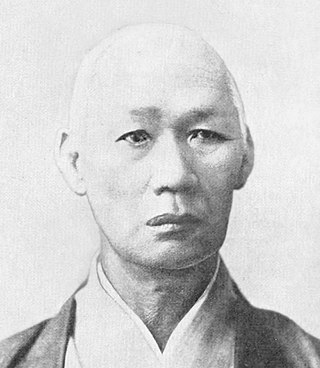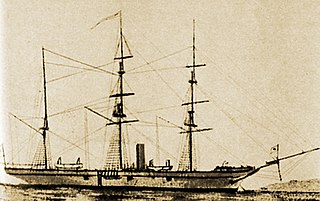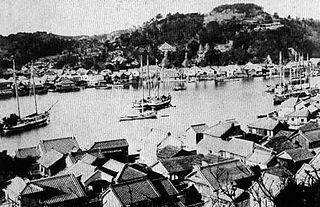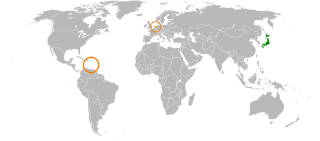
Sag Harbor is an incorporated village in Suffolk County, New York, United States, in the towns of Southampton and East Hampton on eastern Long Island. The village developed as a working port on Gardiner's Bay. The population was 2,772 at the 2020 census.

Bakumatsu was the final years of the Edo period when the Tokugawa shogunate ended. Between 1853 and 1867, Japan ended its isolationist foreign policy known as sakoku and changed from a feudal Tokugawa shogunate to the modern empire of the Meiji government. The major ideological-political divide during this period was between the pro-imperial nationalists called ishin shishi and the shogunate forces, which included the elite shinsengumi swordsmen.

Nakahama Manjirō, also known as John Manjirō, was one of the first Japanese people to visit the United States and an important translator during the Opening of Japan.

The Bonin or Ogasawara Islands are a Japanese archipelago of over 30 subtropical and tropical islands located around 1,000 kilometers (620 mi) SSE of Tokyo and 1,600 kilometers (1,000 mi) northwest of Guam. The group as a whole has a total area of 84 square kilometers (32 sq mi) but only two of the islands are permanently inhabited, Chichijima and Hahajima. Together, their population was 2560 as of 2021. Administratively, Tokyo's Ogasawara Subprefecture includes the Volcano Islands and the Self-Defense Force post on Iwo Jima. The seat of government is Chichijima.

The Town of East Hampton is located in southeastern Suffolk County, New York, at the eastern end of the South Shore of Long Island. It is the easternmost town in the state of New York. At the time of the 2020 United States census, it had a total population of 28,385.

Chichijima (父島) is the largest and most populous island in the Bonin or Ogasawara Islands. Chichijima is about 240 km (150 mi) north of Iwo Jima. 23.5 km2 (9.1 sq mi) in size, the island is home to about 2120 people (2021). Connected to the mainland only by a day-long ferry that runs a few times a month, the island is nonetheless organized administratively as the seat of Ogasawara Village in the coterminous Ogasawara Subprefecture of the Tokyo Metropolitan Government. Together with the Volcano and Izu Islands, it makes up Japan's Nanpō Islands.

Shōhei Maru (昇平丸) was a sailing frigate constructed on orders of the Tokugawa shogunate of Bakumatsu period Japan by Satsuma Domain in response to the Perry Expedition and increasing incursions of foreign warships into Japanese territorial waters. She was built from 1853 to 1854 at Sakurajima in what is now Kagoshima Prefecture. Shōhei Maru should not be confused with the World War II passenger/cargo vessel of the same name, sunk by the submarine USS Spadefish off of Korea.

Kanrin Maru(咸臨丸, Unyielding) was Japan's first sail and screw-driven steam corvette. She was ordered in 1853 from the Netherlands, the only Western country with which Japan had diplomatic relations throughout its period of sakoku (seclusion), by the shōgun's government, the Bakufu. She was delivered on September 21, 1857, by Lt. Willem Huyssen van Kattendijke of the Dutch navy. The ship was used at the newly established Naval School of Nagasaki in order to build up knowledge of Western warship technology.

The Japanese in Hawaii are the second largest ethnic group in Hawaii. At their height in 1920, they constituted 43% of Hawaii's population. They now number about 16.7% of the islands' population, according to the 2000 U.S. Census. The U.S. Census categorizes mixed-race individuals separately, so the proportion of people with some Japanese ancestry is likely much larger.

Sakoku was the isolationist foreign policy of the Japanese Tokugawa shogunate under which, for a period of 265 years during the Edo period, relations and trade between Japan and other countries were severely limited, and nearly all foreign nationals were banned from entering Japan, while common Japanese people were kept from leaving the country.

Ranald MacDonald was the first native English-speaker to teach the English language in Japan, including educating Einosuke Moriyama, one of the chief interpreters to handle the negotiations between Commodore Perry and the Tokugawa Shogunate.

Uraga (浦賀) is a subdivision of the city of Yokosuka, Kanagawa Prefecture, Japan. It is located on the south eastern side of the Miura Peninsula, at the northern end of the Uraga Channel, at the entrance of Tokyo Bay.

The Shinnecock Indian Nation is a federally recognized tribe of historically Algonquian-speaking Native Americans based at the eastern end of Long Island, New York. This tribe is headquartered in Suffolk County, on the southeastern shore. Since the mid-19th century, the tribe's landbase is the Shinnecock Reservation within the geographic boundaries of the Town of Southampton. Their name roughly translates into English as "people of the stony shore".

Chōyō Maru was an early sail and screw-driven steam corvette. She was ordered by the Tokugawa shogunate ruling Japan during the Bakumatsu period from the Netherlands and served as a training vessel, and subsequently served with the nascent Imperial Japanese Navy during the Boshin War. She was lost in combat during the Naval Battle of Hakodate Bay.

The Battle of Hakodate was fought in Japan from December 4, 1868 to June 27, 1869, between the remnants of the Tokugawa shogunate army, consolidated into the armed forces of the rebel Ezo Republic, and the armies of the newly formed Imperial government. It was the last stage of the Boshin War, and occurred around Hakodate in the northern Japanese island of Hokkaidō. In Japanese, it is also known as the Battle of Goryokaku

Mercator Cooper was a ship's captain who is credited with the first formal American visit near Edo, Japan and the first formal landing on the mainland East Antarctica.

Pyrrhus Concer was a former slave from Southampton, New York who was aboard the whaling ship Manhattan that was the first American ship to visit Tokyo in 1845.

The Perry Expedition was a diplomatic and military expedition during 1853–1854 to the Tokugawa Shogunate involving two separate voyages by warships of the United States Navy. The goals of this expedition included exploration, surveying, and the establishment of diplomatic relations and negotiation of trade agreements with various nations of the region; opening contact with the government of Japan was considered a top priority of the expedition, and was one of the key reasons for its inception.
The Coffin family was prominent in the history of whaling in the United States, operating ships out of Nantucket, Massachusetts, from the 17th to 19th centuries. Some members of the family gained wider exposure due to their discovery of various islands in the Pacific Ocean.

Japan–Netherlands relations are the bilateral relations between Japan and the Netherlands. Relations between Japan and the Netherlands date back to 1609, when the first formal trade relations were established.